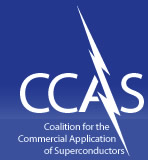Commercial Applications
- Properties, History and Challenges
- Overview
- Electric Power
- Transportation
- Medical Imaging and Diagnostics
- NMR for Medical and Materials Applications
- Industrial Processing
- High Energy Physics
- Wireless Communications
- Instrumentation, Sensors, Standards and Radar
- Large-Scale Computing
- Renewable Energy
- Cryogenics: An Enabling Technology
Overview of Applications
Superconductivity is a unique and powerful phenomenon of nature. Nearly a century after its first discovery, its full commercial potential is just beginning to be exploited.
About Superconductivity
Superconductivity is widely regarded as one of the great scientific discoveries of the 20th century. This miraculous property causes certain materials, at low temperatures, to lose all resistance to the flow of electricity. This state of "losslessness" enables a range of innovative technology applications. During the 21st century, superconductivity is forming the basis for new commercial products that are transforming our economy and daily life.
Current Commercial Applications
- Magnetic Resonance Imaging (MRI)
- Nuclear Magnetic Resonance (NMR)
- High-energy physics accelerators
- Plasma fusion reactors
- Industrial magnetic separation of kaolin clay
The major commercial applications of superconductivity in the medical diagnostic, science and industrial processing fields listed above all involve LTS materials and relatively high field magnets. Indeed, without superconducting technology most of these applications would not be viable. Several smaller applications utilizing LTS materials have also been commercialized, e.g. research magnets and Magnetoencephalograhy (MEG).
The latter is based on Superconducting Quantum Interference Device (SQUID) technology that detects and measures the weak magnetic fields generated by the brain. The current substantive commercial products incorporating HTS materials are electronic filters used in wireless base stations. About 10,000 units have been installed in wireless networks worldwide to date. More detail on these applications is presented in subsequent sections.
Emerging Applications
Superconductor-based products are extremely environmentally friendly compared to their conventional counterparts. They generate no greenhouse gases and are cooled by non-flammable liquid nitrogen (nitrogen comprises 80% of our atmosphere) as opposed to conventional oil coolants that are both flammable and toxic. They are also typically at least 50% smaller and lighter than equivalent conventional units which translates into economic incentives. These benefits have given rise to the ongoing development of many new applications in the following sectors.
Electric Power
Superconductors enable a variety of applications to aid our aging and heavily burdened electric power infrastructure - for example, in generators, transformers, underground cables, synchronous condensers and fault current limiters. The high power density and electrical efficiency of superconductor wire results in highly compact, powerful devices and systems that are more reliable, efficient, and environmentally benign.
Transportation
The rapid and efficient movement of people and goods, by land, sea, and air poses important logistical, environmental, land use and other challenges. Superconductors are enabling a new generation of transport technologies including ship propulsion systems, magnetically levitated trains, railway traction transformers, and research on lightweight aircraft engines.
Medicine
Advances in HTS promise more compact and less costly Magnetic Resonance Imaging (MRI) systems with superior imaging capabilities. In addition, Magnetoencephalography (MEG), Magnetic Source Imaging (MSI) and Magnetocardiology (MCG) enable non-invasive diagnosis of brain and heart functionality.
Industry
Large motors rated at 1000 HP and above consume 25% of all electricity generated in the US. They offer a prime target for the use of HTS in substantially reducing electrical losses. Powerful magnets for water remediation, materials purification, and industrial processing are also in the demonstration stages.
Communications
Over the past decade, HTS filters have come into widespread use in cellular communications systems. They enhance signal-to-noise ratios, enabling reliable service with fewer, more widely-spaced cell towers. As the world moves from analog to all digital communications, LTS chips offer dramatic performance improvements in many commercial and military applications.
Scientific Research
Using superconducting materials, today's leading-edge scientific research facilities are pushing the frontiers of human knowledge - and pursuing breakthroughs that could lead to new techniques ranging from the clean, abundant energy from nuclear fusion to computing at speeds much faster than the theoretical limit of silicon technology.
Issues and Recommendations
Recent progress in superconductivity follows a pattern that marked previous developments in new materials - for example, in transistors, semiconductors and optical fibers. Materials-based technology development entails high risk and uncertainty compared to more incremental innovations. It typically takes 20 years to move new materials from the laboratory to the commercial arena, yet products using new materials often yield the most dramatic benefits for society in the long run.
The long lead times inherent in HTS technology development necessitates a sustained government role, and government-industry partnerships play a pivotal role in this process. These partnerships require stable and consistent funding and a tolerance for risk. Careful planning is required to ensure parallel progress in related fields, such as cryogenics, to assure broad commercial acceptance of new LTS and of HTS technology. Prospective customers such as electric utilities require a stable and symmetrical climate for investment in research, development and demonstration projects.

